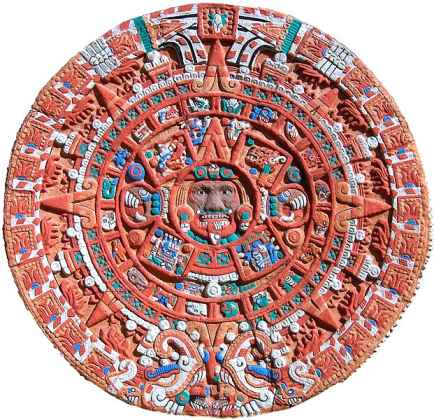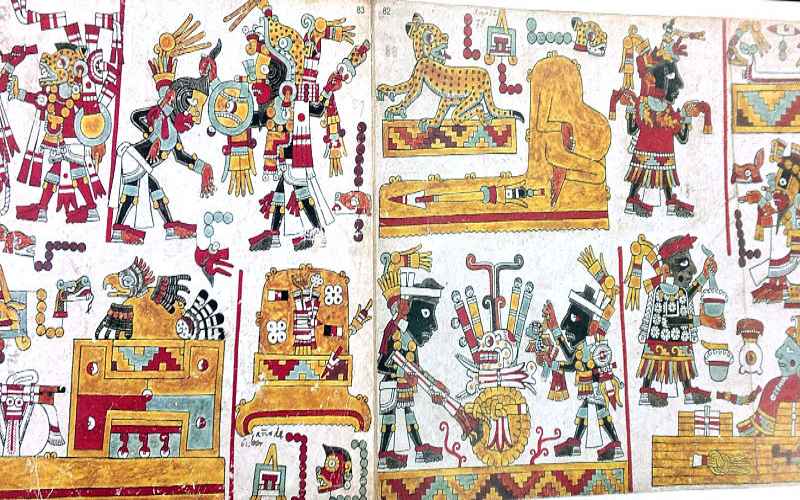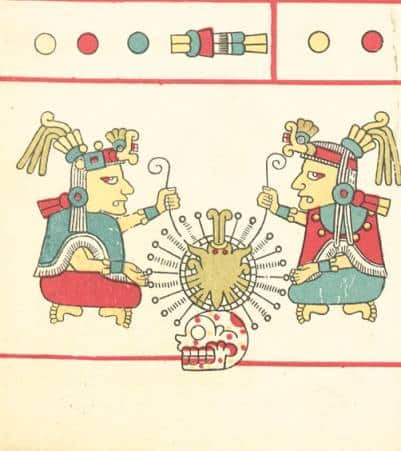The Aztecs, Nahua or Mexica as they called themselves, were a Nahuatl- speaking group of Mesoamericans. The Nahua lived in the region we now call Mexico. The group we call the Aztecs first rose to prominence in Mesoamerica in the 13th century.
This particular Nahuatl- speaking group prospered until the 1500s when they were conquered by the Spanish. They quickly became the dominant cultural group in what is now Central Mexico.
Aztec religion incorporated and borrowed many aspects from other Mesoamerican groups. Several of the Mexica’s beliefs, mythology, and deities were shared with the Olmecs and the Maya. As a result, the Aztec religion consisted of over 200 gods and goddesses.

The Mexica were considered a bloodthirsty bunch. Labeled as such by the Spanish who were the first to encounter the impressive temples of the Aztec capital, Tenochtitlan. In addition to being the first to encounter the Aztecs, much of our knowledge stems from their accounts.
Most of what we know about the religion of the Nahua cultural group is from these 16th-century European accounts. Many of which included some rather gruesome descriptions of rituals.
It was certain religious practices used by the Aztecs to honor their gods that horrified the Spanish. Almost all of the rituals used to appease the numerous gods and goddesses of the Aztec pantheon involved human sacrifice.
What Did the Aztecs Universe Look Like?
The belief held by the Mexica was that the universe was divided into three sections. There were the heavens, the Earth, and lastly the Underworld. The Earth or Tlaltipac was believed to be a disc situated in the middle of the universe.
Those three sections of the universe were connected by a central axis which was the main temple in Tenochtitlan. The Nahua people believed that the universe was made up of thirteen heavenly levels situated above the earth. And then there were the nine Underworld levels, found below the Earth. Each of these levels was presided over by one of the Aztecs’ many deities.
Aztec Religion
The religion of the ancient Mexica was polytheistic, like the ancient Greeks. This meant that every aspect of the Aztec universe was given a patron deity to rule over it. Mythology and religion played an essential part in the lives of the Mexica people of ancient Mexico. Central to the Aztec religion was the cycle of birth, death, and rebirth and the story of the Five Suns.
A recurring theme throughout the religion of the Mesoamerican people was that of opposites. Such as night and day, and the balance that needed to be maintained throughout the universe.
Religion shaped their worldview and played a role in the views around the founding of their cities. The founding of the Mexica capital, Tenochtitlán is steeped in myth and folklore. The myth tells of the god Huitzilopochtli who was at the top of the godly hierarchy. He lead the first people from a mythical land of plenty to the site that would become Tenochtitlán.
The Aztec Creation Myth, The Five Suns
The creation myth of the Aztecs embodies the ancient Mexica’s belief in the cycle of birth, death, and rebirth. So their creation myth is slightly more apocalyptic than others. This myth is known as the Five Suns.
In the beginning, there was nothing but an empty void. Then out of this eternal void, the first being or beings depending on which source, emerged. This god has been described as being one god or a dual god called Ometeotl. However, sometimes the myth tells of there being two beings, a male, Ometecuhtli, and a female Omecihuatl who merged to form one being.
This primordial being was both male and female, good and evil, chaos and order. It was Ometecuhtli who created the first four gods, who in turn, created the universe and all other deities. However, they could not create the sun. The god Tezcatlipoca sacrificed himself to create the sun.
The Nahua cultural group to which the ancient Aztecs belonged, believed that the world had been created, destroyed, and reborn five times. This meant that five different suns had been made and four different cycles, all presided over by a different ruling deity.
According to the Sun Stone, found buried within the ruins of the Mexica’s capital, the Aztecs believed they were living in the fifth cycle. The dominant god for this cycle was the sun god, Tonatiuh. They called themselves the People of the Sun.
The Aztec Calendar
Before we dive into the more intricate aspects of Aztec religion it is important to understand how the Aztec calendar worked. Above all, their religion was intricately interconnected with their calendar. However, that calendar wasn’t entirely unique to the Aztec.
The Mexica religion and rites were interwoven with the ancient Mayan calendar, which as with many aspects of their religion, the Aztecs incorporated into their belief system.
The calendar year for the Aztecs consisted of 18 months. They followed a 365 solar cycle, and a 260-day ritual cycle, which aligned every 52 years. At the end of the 52 years, the Aztecs would take part in the New fire ceremony to ensure their universe would continue to thrive.
The New Fire ceremony, however, did not simply involve prayer and a symbolic lighting of a flame. This ritual involved human sacrifice. The details of this particular ritual are fairly graphic and nightmare-inducing.
Pantheon of the Aztecs
The many spectacular deities that make up the Aztec pantheon can be divided into three groups, with each group overseeing a certain aspect of the universe. The first group consists of the creator gods. The first being, the dual god, Ometecuhtli belongs to this group.
The second group consists of those deities who represent the life-giving force of rain, agriculture, and fertility. The main deity within the second group is the god Tlaloc. The third group of gods and goddesses is a broad one, encompassing all those beings who presided over war and sacrificed the sun and earth.
It is in the third group that the primary goddess of the earth, Cōātlīcue belonged. In addition to Cōātlīcue, there were several goddesses of the earth.
Several of the deities that the dominant Mesoamerican group worshiped appear to be viewed as a force, rather than a god or goddesses with human characteristics and personalities. The gods and goddesses of the Mexica were powerful forces that manifested in their world.
The Many Gods and Goddesses of the Aztecs
The gods and goddesses worshiped by the Mexica were a violent and bloodthirsty group. The vast pantheon consisted of over 200 deities. A great deal of them were deities incorporated from other Mesoamerican cultures.
The people conquered by the ancient Mexica were allowed to continue practicing their own religion, as long as they incorporated the worship of the Aztec supreme being.
The Aztecs would often place a statue of their newly conquered subjects’ supreme being, in their temples to incorporate the beliefs of their new subjects. This is perhaps why the pantheon of the Aztecs was so large.
Each god or goddess was connected in some way to the everyday life of the Mexica people. There were gods of the rain, and maize, as well as the god of the fire and Chantico, the goddess of the hearth.
Deities represented the earth, seasons, and natural phenomena found within the cosmos. For example, the Milky Way, known to the Mexica as the goddess Coyolxāuhqui.
The Prominent Gods and Goddesses of the Aztecs
Although there were over 200 deities within the Aztec pantheon, there were four gods that were at the forefront of religious practices. The four main gods were Huitzilopochtli, the hummingbird god of war, and the sun. Quetzalcoatl, the feathered serpent who was the creator of mankind.
Next, there was Tlaloc the god of rain and earthly fertility, he was as important to the Aztecs as Huitzilopochtli. The third god was Mixcoatl, the god of warriors and sorcerers. Finally, Xipe Totec, the ‘flayed man’ who was the god of spring and new vegetation.
These four gods also represented the four directions of the earth, North, South, East, and West. Many of the male gods had female counterparts. For example, the god of death, Mictlantecuhtli was believed to be married to the female goddess of death. Her name was Mictecacihuatl and she ruled over the Underworld.
Some gods and goddesses represented the stars, sun, moon, mountains, streams, frost, and seeds. Although the pantheon was dominated by male deities, several equally important goddesses presided over important aspects of Aztec life.
The goddess Chalchiuhtlicue for example, was the goddess of freshwater streams, rivers, and lakes. Another important female figure was the goddess Chicomecoatl, who was a goddess of food. She was specifically associated with corn seed, the dominant crop for ancient Mexica.
The Most Significant Aztec Goddesses
As you can see, the Aztecs had many powerful gods and goddesses, and since the main focus is on the goddesses, here is a list of the most importan ones:
- Xōchiquetzal – Goddess Of Love, Flowers, And Beauty
- Chalchiuhtlicue – Goddess Of Fertility And Freshwater
- Mictecacihuatl – Goddess That Ruled The Underworld
- Cōātlīcue – Goddess Of Earth And Motherhood
- Coyolxāuhqui – Goddess Of The Moon And Milky Way
- Mayahuel – Goddess Of Maguey Plant
- Huixtocihuatl – Goddess of Salt
- Chantico – Goddess of Firebox and Volcanoes
- Meztli – Goddess of the Moon, sometimes thought as the same as Coyolxāuhqui
- Tlazōlteōtl – Goddess of Sin and Lust
- Citlalicue – Goddess of Female Stars in the Milky Way
- Tonacacihuatl – Goddess of Sustenance
- Chicomecoatl – Goddess of Agriculture
- Toci – Goddess of Health
- Itzpapalotl – Death Goddess, “Obsidian Butterfly”
Aztec Religious Traditions
In the 1500s, the Spanish Conquistadors who first encountered the Mexica people were horrified by the rituals they witnessed. Reports were sent to Spain detailing the Aztecs’ gruesome practice of ritual human sacrifice and cannibalism. Understandably, these horrified the Spanish public.
Initially, modern scholars and archeologists thought the 16th-century accounts of the gruesome ways the Aztecs honored their gods and goddesses to keep the balance in their universe were exaggerated.
They certainly did not believe that there were thousands of people who died in this manner. That was until a shocking discovery was made beneath the Templo Mayor. Hundreds of human skulls were found strung together on wooden pikes, just as the Spanish conquistadors had described.
Center of the Aztecs Religion
In the center of the ancient capital city of the Mexica, Tenochtitlan, there was once an impressive double temple, now known as the Templo Mayor. This temple was the center of not just the ancient Mexica capital city, but of their religion.
The Templo Mayor was an impressive example of ancient engineering built to worship two gods, in particular, Tlocl and Huitzilopochtli. It was on the top of this temple that thousands of people would meet their end, being ritualistically sacrificed to appease the bloodthirsty god of war and the sun and the god of the rain.
At the base of the temple, archaeologists found a rounded stone slab, depicting the dismembered body of the goddess Coyolxauhqui. The myth of how this particular goddess met her demise plays an important role in how several rather (un)lucky members of Aztec society were…repurposed.
Coyolxauhqui along with her 400 hundred brothers known as the Centzon Huitznahua, plotted to kill their mother, Cōātlīcue the goddess of the earth. The attack was orchestrated because Cōātlīcue had become pregnant with the god of war and sun, Huitzilopochtli.
The attack is thwarted by Huitzilopochtli, who emerges from his mother’s womb as a fully armed warrior. He kills Coyolxauqui by beheading her. The ruler of the gods threw the body of Coyolxauqui from the top of Coatepec, also known as Serpent Mountain. The body of the goddess broke into pieces before hitting the ground.
The slab is believed to have been placed at the base of the sacred temple as a warning. Throughout Aztec mythology, female goddesses were the first to die in war.
Aztecs and Ritual Human Sacrifice
For the ancient Nahua, state-mandated human sacrifice was a common occurrence. They were also not the only Mesoamerican cultural group to participate in the tradition. Human sacrifice for the Aztecs was believed to be necessary to appease the gods. In addition, it was to maintain balance and nourish the Aztec deities. If the gods were well-fed, there would be no drought, disease, or conquest.
There were several different types of rituals in which humans were sacrificed, each depending on the god being honored. The ancient Mexica believed that the god of the sun and war, Huitzilopochtli, was locked in an unrelenting war with darkness, which if he lost would mean the end of the world.
To aid the god in his war, the Mexica had to nourish him with human blood, hearts, and the energy released from the body after death. In an offering to the god, the chosen sacrifice would be led to the altar on the Templo Mayor, where their heart would be cut from their body using an obsidian blade.
The still-beating heart would be thrust towards the sky in an offering to the god. The sacrifice would then meet a fate that mirrored the goddess Coyolxauqui, being decapitated, dismembered, and then thrown from the top of the temple.
The majority of those chosen to be sacrificed were men, but women and children were sometimes sacrificed too. Occasionally, the most elite members of Aztec society would participate in ritualistic cannibalism.
Why Did the Aztecs Practice Human Sacrifice?
So, why did the Aztecs cut out the still-beating hearts of their sacrificial victims? It had to do with the Aztec beliefs involving the energy of the universe and the human body. The human body was a sacred vessel of cosmic energy to the ancient Aztecs. According to the Codex Mendoza, the belief was that humans contained two forces of the universe known as Tonali and Teyolia.
Tonali was believed to be present in people’s heads and hair, put there by the creator god Ometecuhtli. Tonalli was believed to be the source of a person’s strength, which upon their death would be released, nourishing the sun.
Teyolia however, was found in the human heart and was seen as the divine light or fire of human life. It was believed to be the source of a human’s intelligence, wisdom, and passion. The forces of Tonali and Teyolia moreover were thought to flow through every living thing on the earth, not just humans.
To maintain balance in the universe, which was achieved through nourishing the gods and goddesses, the energy that flowed through human beings was sacrificed to the gods.
The Aztecs were deeply ritualistic, so rites would take place during each of the 18 months.
In addition, the Aztecs practiced human sacrifice to maintain order throughout their empire. The practice ensured their subjects feared them and intimidated all those who would oppose them. Often those who were sacrificed on the temple altar were prisoners of war.
The Origin of El Dia De Los Muertos
El Dia De Los Muertos or Day of the Dead is a Mexican holiday that takes place from the 31st of October to the 2nd of November. For this brief period, the souls of the dead are welcome back to the earthly plane by their families.
The belief is that the gates of heaven are opened for a brief time, allowing families to reconnect. During this time, the souls of children are believed to visit their families on the 31st of October. While adults visit on November 2nd, the date traditionally associated with the Day of the Dead. Families welcome their dead by hosting a large colorful celebration with food and drink.
The Aztecs Connection to El Dia De Los Muertos
This popular holiday can trace its origins to the Aztecs. Like the contemporary belief, ancient Nahua people believed that when someone died, their soul entered the Underworld. The soul would be faced with several challenges as it made its way through the nine levels of the Underworld.
Once a soul reached the final level called Mictlán, the soul would be at peace. The Aztecs believed the soul needed help to reach this level. So, family members would provide water, food, and tools for the souls. However, unlike El Dia De Los Muertos, this ritual was performed in August.
It was this practice by the Aztecs, the ritualistic provision of food and water to their deceased family members that inspired the modern holiday celebrated in Mexico. Today, during Day of the Dead celebrations, people leave food and drink for their loved ones as an offering to coax them into visiting their earthly home.
Other Goddesses
If you enjoyed this post we are sure you will enjoy getting to know some of the other goddesses we also write about. You can find the complete list of goddesses sorted across regions and religions here.
Goddess Jewelry
There are many reasons why you might want to keep a healing crystal or stone close to you. Getting closer to your goddess by wearing her color or crystal is a great one. That they also look great as jewelry only makes it so much better!
Here is a guide to crystal jewelry you hopefully will find helpful. In it is a list of 30+ crystals and links to some really great looking jewelry with that crystal or stone. Enjoy!
Featured Image Credit: Wikimedia Commons




